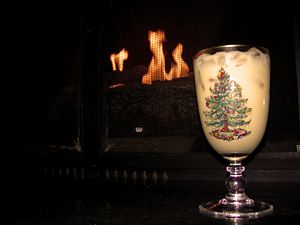Eggnog: Difference between revisions
imported>Hayford Peirce (another curious fact) |
mNo edit summary |
||
| Line 5: | Line 5: | ||
Commercial, packaged drinks called "eggnog" are available in supermarkets during the "Holidays", in the United States, the period between [[Thanksgiving]] and [[New Year's Day]]. These typically contain some desiccated egg and dairy food product<!--we can only hope-->, plant fillers and food coloring. To a discriminating palate they do not taste very much like proper eggnog. | Commercial, packaged drinks called "eggnog" are available in supermarkets during the "Holidays", in the United States, the period between [[Thanksgiving]] and [[New Year's Day]]. These typically contain some desiccated egg and dairy food product<!--we can only hope-->, plant fillers and food coloring. To a discriminating palate they do not taste very much like proper eggnog. | ||
The French term for eggnog is, curiously enough, ''lait de poule'', or chicken milk. | The French term for eggnog is, curiously enough, ''lait de poule'', or chicken milk.[[Category:Suggestion Bot Tag]] | ||
Latest revision as of 16:00, 10 August 2024
Eggnog is a special-occasion punch made from raw eggs, milk, cream and a large quantity of sugar. It is traditional to add rum to taste, although bourbon whiskey and other spirits may be used, and non-alcoholic versions are often served as well. Although its roots are in various European punches, eggnog (or egg nog) in its current form is uniquely American.
Commercial, packaged drinks called "eggnog" are available in supermarkets during the "Holidays", in the United States, the period between Thanksgiving and New Year's Day. These typically contain some desiccated egg and dairy food product, plant fillers and food coloring. To a discriminating palate they do not taste very much like proper eggnog.
The French term for eggnog is, curiously enough, lait de poule, or chicken milk.
